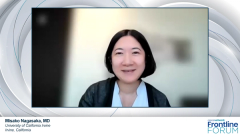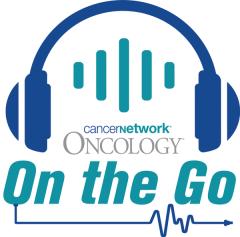
Trial Data and Experience With Amivantamab in EGFR Exon20+ NSCLC
Expert perspectives on clinical trial data and personal experience with amivantamab in the setting of EGFR Exon20+ non–small cell lung cancer.
Episodes in this series

Transcript:
Joshua K. Sabari, MD: Let’s dig into the data. I’ll talk about amivantamab. I’ll allow you to then talk about mobocertinib. And I want to have a discussion about…factors…you think about in your decision-making discussion with patients. First to introduce amivantamab, which you’ve heard about already. It’s an EGFR and c-MET bispecific antibody. So a very interesting construct. It is an infusion therapy, and the mechanism of action is interesting. It has multiple mechanisms here, in the sense that it can bind, ligand binding in the cell membrane, leading to inhibition. You also see an immune-mediated activity in the sense of trogocytosis, or engulfing of tumor cells by macrophages, and there’s also this cellular ADCC, or antibody-dependent cellular cytotoxicity. So both a direct inhibitory activity as you would think a small molecule, but also potentially an immune-mediated activity in this patient population. And Dr Nagasaka and [I], we were both involved in the development of this agent early on, and it was exciting to see the broad activity of amivantamab across all [patients with] EGFR [mutations], including the common mutations, exon 19 del and L858R, as well as the uncommon or rarer EGFR exon 20 insertions. And on the phase 1 dose escalation, we saw a 30% response rate in patients with EGFR exon 20 insertion mutations, and this led to a confirmatory cohort of expansion population, specifically in patients with EGFR exon 20 who had received frontline therapy with platinum doublet. So that was a large study, over 120 patients treated with amivantamab at the recommended phase 2 dose, which is 1050 mg in patients weighing less than 80 kg, and 1400 mg in those patients weighing greater than or equal to 80 kg. And it’s important to note that this is a therapy that’s given somewhat uniquely. It’s not an infusion once every 3 weeks. But it’s a weekly infusion for the first 5 times, followed by biweekly. And we saw early on an interesting infusion-related reaction. I’m curious, Dr Nagasaka, have you seen, obviously, those infusion-related reactions…?
Misako Nagasaka, MD: All the time.
Joshua K. Sabari, MD: What does that look like in your practice?
Misako Nagasaka, MD: It depends. Some patients have chills, rigors, low-grade fever, chest discomfort, shortness of breath. It’s all over the place. When you first see it, it’s scary. But at this time, all the nurses are well used to this.
Joshua K. Sabari, MD: And when are you seeing it? When does it occur in your patient population?
Misako Nagasaka, MD: It almost always occurs on the first infusion, if it were to occur. And the chances of it occurring again on the second day of the first week are 1% or less. Very uncommon to see it happen again.
Joshua K. Sabari, MD: Early on in the development of this agent, because we were seeing 65%, 70% of our patients having this infusion-related reaction, which, generally when you stop the medicine or slow down the rate, you can overcome, we decided to split the dose early on so patients [had] a test dose of 350 mg on cycle 1, day 1, and the rate of infusion reaction is high there. And like Dr Nagasaka mentioned, we bring them back on cycle 1, day 2, to give the remainder of the infusion. And I’ll tell you, in my practice, usually 35 to 40 minutes into the infusion, if the patient looks at me the wrong way or has flushing, I generally stop medicine that day to try to avoid a full-blown infusion-related reaction. As you mentioned on cycle 1, day 2, the rate of the reaction is in that 1% range. We then do give the therapy weekly for the first 4 weeks. And it’s important to note that initially, early on in giving this therapy, we do prophylaxis patients with steroids, antipyretics, for example, acetaminophen, as well as medications that may reduce symptoms during that reaction. And as you continue, by day 15, for example, I do tend to peel off a lot of these supportive medications for patients. So, in this study, cohort D of the CHRYSALIS trial [NCT02609776], the phase 1 expansion was cohort D, where we treated about 120 patients who had EGFR exon 20 insertions. Aside from the infusion-related reaction, we saw a clean toxicity profile. So things like rash and diarrhea, which you expect to see from EGFR and HER2 TKIs [tyrosine kinase inhibitors], we saw a very low rate. So clinically significant rash less than 5%. Clinically significant diarrhea even lower in that patient population. We did see some edema that developed over time, and that’s really from the MET-mediated toxicities. But again, nothing that was too difficult to manage in clinical practice. So what was the efficacy here? The efficacy was quite impressive. We saw an objective response rate of about 40% in this population, who would receive prior platinum doublet, a median progression-free survival of 8.3 months, and overall survival reaching into that 23-month range in this patient population. Median duration of treatment was [in] the 11- to 12-month range in this group. Now, thinking about these data, this led to the FDA approval of amivantamab in [patients with] EGFR exon 20 insertion [mutations]. This was the first FDA-approved therapy in this patient population. And it changed the landscape for patients with EGFR exon 20 disease because prior to this, we didn’t have any targeted therapy options. I will mention that this medicine is potentially moving into the frontline setting. There is an ongoing trial, the PAPILLON trial [NCT04538664], comparing chemotherapy plus amivantamab vs chemotherapy alone. It’s a phase 3 global randomized registrational study. I look forward to seeing the data in the near future.
Transcript edited for clarity.
Newsletter
Stay up to date on recent advances in the multidisciplinary approach to cancer.





















































































